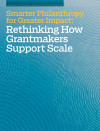SUPPLEMENT TO SSIR SPONSORED BY GRANTMAKERS FOR EFFECTIVE ORGANIZATIONS
Smarter Philanthropy for Greater Impact

This special supplement includes eleven perspectives on “scaling what works”—what it means, what it takes to do it right, and what needs to happen to increase the impact of successful solutions to social challenges.
-
What Would It Take?
-
Emerging Pathways to Transformative Scale
-
Pathways to Scale for a Place-Based Funder
-
The Road to Scale Runs Through Public Systems
-
From Innovation to Results
-
Perspectives on the Social Innovation Fund
-
Partners in Impact
-
We Need More Scale, Not More Innovation
-
More Resources, More Co-Investors, More Impact
-
In Collaboration, Actions Speak Louder than Words
-
Leveraging a Movement Moment
Several years ago, the board and staff of the Edna McConnell Clark Foundation (EMCF) settled on a new approach to advance the foundation’s goal of transforming the life trajectories of economically disadvantaged young people. Under this strategy, which we refer to as “growth capital aggregation,” we work with co-investors to deliver more capital and resources to organizations that have demonstrated the strongest evidence of success.
Since launching the Growth Capital Aggregation Pilot on behalf of three grantees in 2007, we have leveraged $90 million of our own resources to help 16 grantees secure nearly $280 million in additional funding from 50 private co-investors and the federal government.
What began as an experiment has evolved into EMCF’s core investment strategy. Currently, we are focused on two areas: supporting four grantees (Citizen Schools, Harlem Children’s Zone, Nurse-Family Partnership, and Youth Villages) in separate, individually structured co-investments; and working in partnership with 14 philanthropic co-investors to support a pool of a dozen grantees through our work as an intermediary of the federal Social Innovation Fund. (For more on the Social Innovation Fund, see pages 14 and 15.) We and our co-investors aggregate our funding through what we call the True North Fund.
How It Works
Although growth capital aggregation is still a work in progress, we have learned five lessons about how to make the process work.
Co-investors and the grantee need to unite around a single growth plan. Agreeing to the same terms and conditions of investment, performance measures, reporting, and payout creates efficiencies for the co-investors and above all for the grantee. This makes co-investors and the grantee partners in the pursuit of a common, shared objective. Furthermore, freed from having to report individually to diverse funders and meet their differing demands, the grantee can concentrate on executing its growth plan.
Co-investors should provide at the outset all of the capital the growth plan requires. For-profit corporations would never embark on an ambitious business plan without the funds to see it through, yet funders routinely expect nonprofits to launch an initiative that is not fully capitalized. Growth capital aggregation enables a grantee to see its plan through, uninterrupted by the necessity to raise more capital. In a 2012 study of the impact of the growth capital aggregation pilot on the three participating grantees, researchers Bill Ryan and Barbara Taylor concluded, “Today all three grantees are much stronger organizations. They serve more youth, earn more annual revenue, and are well-positioned to benefit from new federal funding opportunities for proven programs. And they accomplished all of this in the midst of the worst economic downturn the U.S. has seen since the Great Depression.”1
Co-investors should link growth capital to performance rather than programs. Philanthropy frequently limits its support to programs and imposes restrictions that prevent nonprofits from investing to build their evidence base and their organizational capacity, which are prerequisites for sustainable growth. EMCF grantees are free to put their growth capital to any uses that will help them build their capacity for expansion, improve the quality of their programs, or sustain them at greater scale. Although our grants are unrestricted in this sense, we hold grantees strictly accountable for—and payout is contingent on—meeting annual milestones for performance based on their growth plans. Grantees and all co-investors agree up front on what the milestones are. In return, EMCF and co-investors agree to provide all the assistance we can to help grantees meet those milestones.
Creating strong relationships among co-investors requires transparency and accountability. In addition to holding grantees accountable, EMCF holds itself accountable to our co-investors. Our partners, after all, have invested their money and their trust alongside us, and we report to them quarterly as fully and as scrupulously as we do to our board of trustees. Foundations are not accustomed to holding themselves accountable to other funders the way nonprofits do, and conducting ourselves differently has posed challenges. But it has been worth it. This transparency has strengthened our co-investors’ confidence in us and deepened our partnerships. Acknowledging honestly whatever problems grantees encounter has made it easier for us to help them solve those problems. And making ourselves accountable to co-investors has made us more understanding of the challenges our grantees experience when they report to us.
Growth capital should be focused on sustainability and scale. Support from the True North Fund is intended to help propel a nonprofit from one level to the next and ensure that reliable, renewable funding can sustain its operations and its quality at the new, greater scale. The Center for Employment Opportunities (CEO), for example, is a True North Fund grantee that helps people recently released from prison find employment and avoid recidivism. Federal dollars from the Social Innovation Fund and private dollars from the True North Fund helped CEO gain a foothold in California, where it recently won a major state contract.
Philanthropy can’t solve all social problems on its own. But at EMCF, we believe we have identified one way for philanthropy to help: by capitalizing proven organizations more effectively and providing them with the resources that they—and the vulnerable populations they serve—deserve.
Support SSIR’s coverage of cross-sector solutions to global challenges.
Help us further the reach of innovative ideas. Donate today.
Read more stories by Nancy Roob.

